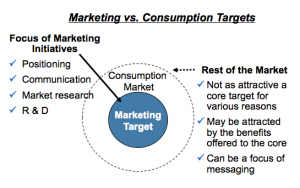 Target marketing is one of the most important, though often overlooked, components in developing a sound marketing plan. Targeting recognizes the fact that most companies have limited resources and therefore, need to “place their bets” where they will yield the highest return.
Target marketing is one of the most important, though often overlooked, components in developing a sound marketing plan. Targeting recognizes the fact that most companies have limited resources and therefore, need to “place their bets” where they will yield the highest return.
Many companies are reluctant to select a defined core target segment, fearing that excluding certain groups will decrease an important source of volume. In turn, companies try to serve all customer groups equally, which can result in a diffused offering, that no one group finds appealing.
Marketing Target vs. Consumption Target
“Speak to the target, but let others listen,” as stated by advertising legend Leo Burnett, distills target marketing down to actionable insight.
More adept marketers understand the important distinction between 1) the more narrow “target market” (think the center of the bullseye); and 2) the broader “consumption market” that falls outside of the core target, though often finds the offering appealing.
The following illustrates this important distinction:
Target Marketing in Practice
Apple has expertly targeted iPod and iTunes, focusing on a specific market though appealing to a much broader group. By selecting younger, hard-core music aficionados as their marketing target, Apple was able to concentrate its early product development and marketing dollars on a fairly defined core target that would set the highest expectations for the brand. While Apple understood the much broader market potential, it initially focused on capturing heavy users of music, to establish a strong, loyal customer base. This core target then extended the brand through strong word-of-mouth and viral marketing. Eventually, a much broader consumption market began purchasing iPods, and sales skyrocketed. Still, Apple has maintained its narrow targeting strategy throughout, recognizing the ‘aspirational’ nature of its core marketing target, which the broader consumption market also finds appealing.
Marketing vs. consumption target cases:
- Nike focuses its product development and marketing budget on performance athletes, though the weekend warrior is a strong consumption market
- Gatorade emphasizes ‘re-hydration’ benefits in targeting athletes and young adult males. Much broader consumer groups use Gatorade across a variety of usage occasions
- Pharmaceutical companies often target thought leaders and specialty physicians to endorse the brand’s effectiveness, with primary care physicians and pharmacists considering the consumption market
Key Issue: Who Not To Target?
In our experience, one of the root causes of a poor marketing plan is often a failure to select a core marketing target. Companies that try to be all things to all people often do not stand for any one thing, resulting in murky marketing or a poorly positioned offering. In marketing an offering, rather than asking the question, “Who should we target?” the more useful question becomes, “Who shouldn’t we target?”
By posing the question this way, it forces the discipline of making trade-offs in focus and spending. Defining the center of the bulls-eye, and also the segments that fall just outside of the center, helps companies explicitly determine which groups will receive focused investment and marketing decision-making.
Determining who not to target can be difficult, though making these hard decisions in the planning stages will help increase the chances of market success. As exemplified by Apple, Nike, Gatorade, and others selecting a narrow marketing target does not necessarily translate to a loss of business potential. In fact, it often means just the opposite.
For more information on how to go about Improving Target Marketing please contact Tim Koelzer at EquiBrand




















Follow EquiBrand